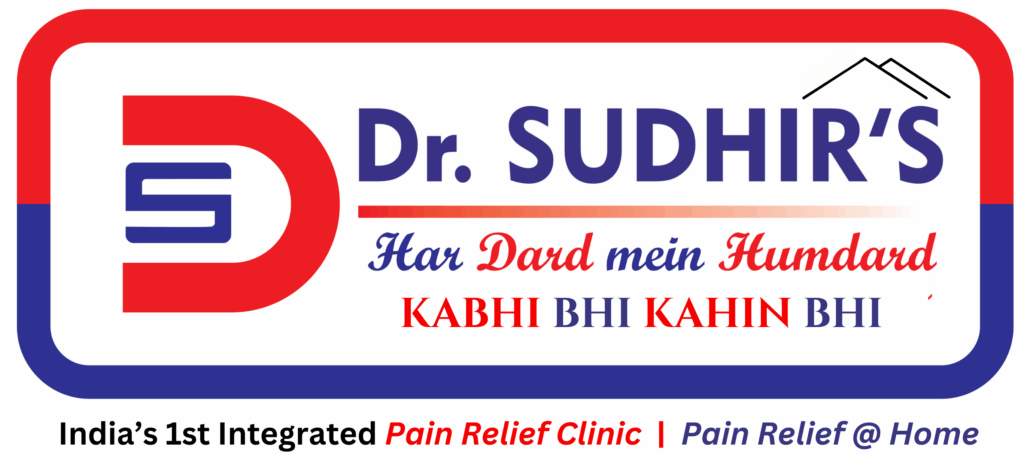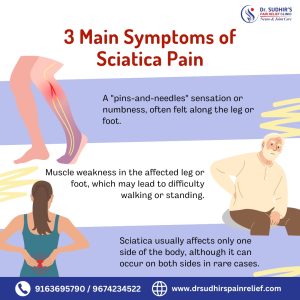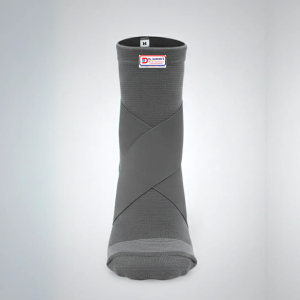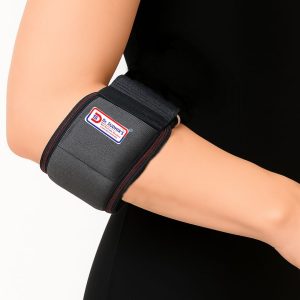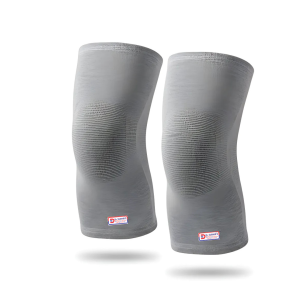Sciatica symptoms occur when the sciatic nerve, the largest nerve in the body, becomes compressed or irritated. This nerve runs from the lower back, through the hips and buttocks, and extends down each leg.
Sciatica symptoms & treatment
The symptoms can range from mild discomfort to debilitating pain and are typically experienced on only one side of the body. Below is a comprehensive breakdown of the most common sciatica symptoms:
Pain Along the Sciatic Nerve Pathway
- Location: Pain often starts in the lower back and radiates through the buttocks and down the back of the thigh. It may extend to the calf and sometimes even the foot.
- Type of Pain: The pain can vary from a dull ache to sharp, stabbing, or shooting sensations. Some describe it as a burning or electric shock-like pain.
- Severity: The intensity can range from mild discomfort to severe, debilitating pain that interferes with daily activities.
Numbness and Tingling (Paresthesia)
- A “pins and needles” sensation is common in the affected leg or foot.
- Some areas may feel numb or have reduced sensitivity to touch, often alongside the pain.
Muscle Weakness
- The affected leg may feel weaker, making it difficult to stand, walk, or perform movements requiring strength in the lower limb.
- Specific muscle groups, like those controlling the ankle or toes, may show noticeable weakness.
Worsening Pain with Movement
- Sciatica symptoms often intensify during certain activities or movements, such as:
- Sitting for prolonged periods.
- Standing for long durations.
- Coughing, sneezing, or straining.
- Bending or twisting the spine.
Loss of Reflexes
- Reflexes in the affected leg, especially at the knee or ankle, may diminish, further indicating nerve involvement.
Bowel or Bladder Issues (Rare)
- In severe cases, sciatica can lead to loss of control over bladder or bowel functions. This is a medical emergency and may indicate a condition called cauda equina syndrome.
Treatment for sciatica aims to relieve pain, reduce inflammation, and address the underlying cause of nerve compression. Depending on the severity of the condition, treatments can range from self-care measures to advanced medical interventions.
Self-Care Measures
Mild sciatica often improves with home treatments:
- Rest: Avoid activities that worsen the pain, but do not remain inactive for too long. Gentle movement promotes healing.
- Cold or Heat Therapy:
- Use an ice pack during the first 48 hours to reduce inflammation.
- Apply a heating pad after 48 hours to relax tense muscles.
Physical Therapy
- Stretching Exercises: Focus on improving flexibility in the lower back and legs. Examples include the piriformis stretch or knee-to-chest stretch.
- Strengthening Exercises: Core and back-strengthening exercises can stabilize the spine and prevent future flare-ups.
- Postural Training: Correcting posture reduces pressure on the sciatic nerve.
- Chiropractic Adjustments: Spinal manipulation can help alleviate sciatica symptoms by reducing nerve compression in some cases.
- Acupuncture: May reduce pain by stimulating specific points on the body.
- Massage Therapy: Relieves muscle tension and improves blood flow to the affected area.
Lifestyle Adjustments
- Weight Management: Excess weight puts extra stress on the spine.
- Exercise: Regular physical activity, such as swimming or walking, helps strengthen the back and reduce the recurrence of sciatica symptoms.
- Ergonomic Improvements: Use supportive chairs and maintain good posture during work.
Understanding sciatica symptoms in detail can help in identifying the condition early and seeking appropriate treatment.
